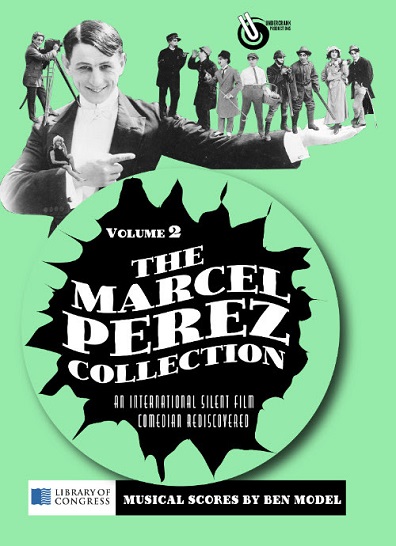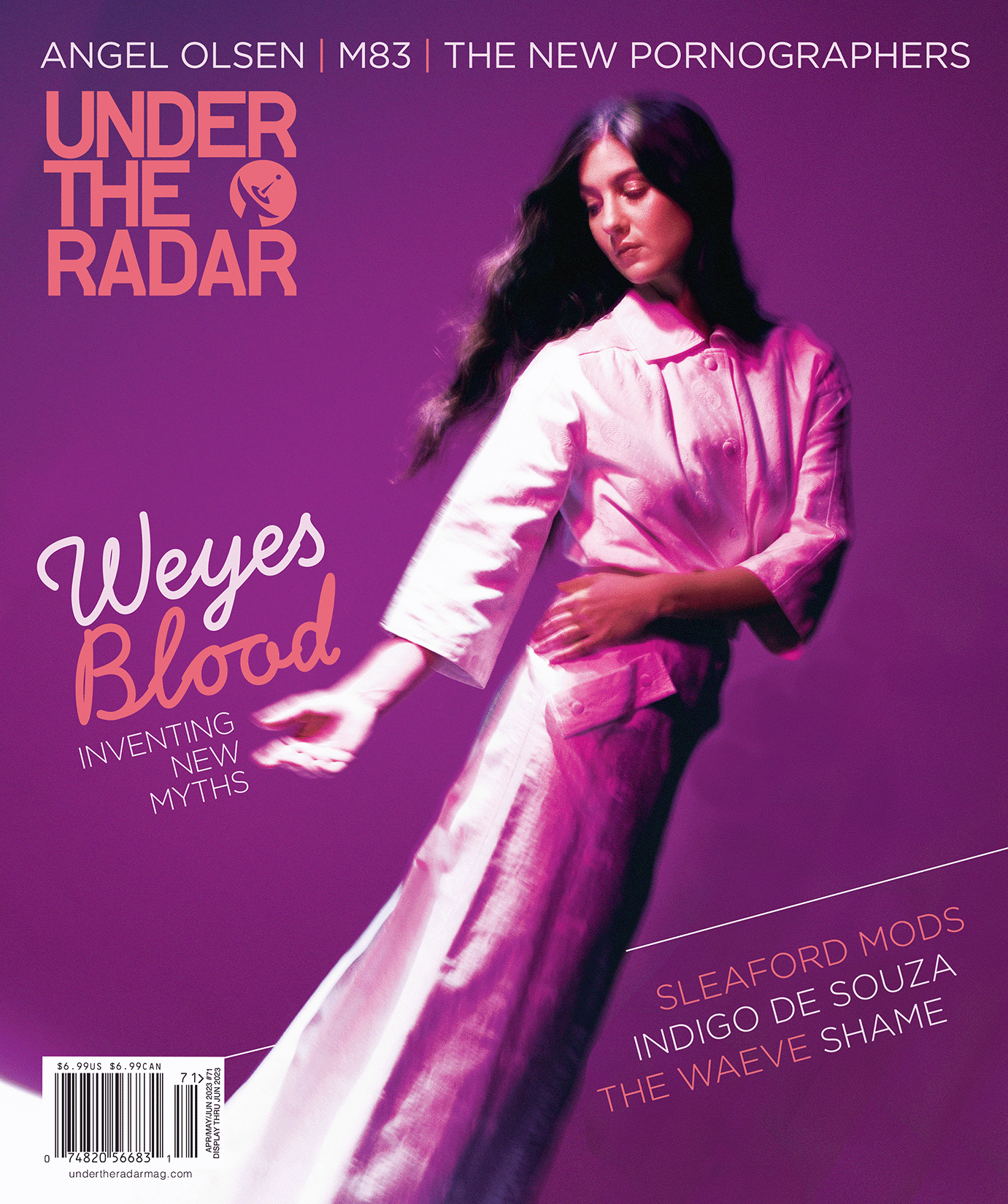
The Marcel Perez Collection, Vol. 2
Studio: Undercrank Productions
Apr 17, 2018
Web Exclusive
![]()
Silent comedy is a form that’s fueled by calamity. If your star is wearing a crisp white suit, it’s only a matter of time before they end up getting buried under an avalanche of dirty coal. No walk down the street is complete without a falling safe or the frame of a house collapsing on our hero. Runaway trains, freak explosions, stepping into puddles that turn out to be deeper than lakes — all in a day’s work for whichever poor soul in an ill-fitting suit has their name front & center on the title card.
Misfortune is so deeply intertwined with the dawn of film comedy that it followed its stars offscreen. Whether it was Chaplin getting banned from the U.S., Buster Keaton languishing in obscurity for the last half of his life, or Fatty Arbuckle’s career getting torpedoed by sex scandals, it was as if their lives were at the mercy of cosmic gag writers with a sadistic streak.
But few silent stars had to follow a life script that was as unforgiving as Marcel Perez’s.
An international silent film star hailing from Madrid, Perez got his start making silent films in Italy before crossing over to the States during the first World War. Writing and directing comedy shorts starring himself (and occasionally sharing the screen with wife Dorothy Earle), Perez was a prolific filmmaker until health problems started to get the better of him. Complications with cancer led to his leg getting amputated in 1923; Perez continued working as a director and gagman until his death in 1929.
Like many other silent film pioneers, Perez’s legacy was in danger of fading completely into oblivion thanks to most of his film prints being unavailable (either due to nitrate decomposition, being melted down for their silver content by distributors, or just plain getting lost). Despite making hundreds of films in Italy and the U.S., only a fraction remain viewable. But thanks to the efforts of Undercrank Productions, Perez’s surviving filmwork can now found a place of honor next to Keaton, Langdon, and Lloyd in any film buff’s library.
Sourcing prints from the Library of Congress and MoMA, Undercrank’s Ben Model has released two DVD collections of Perez’s work (funded by Kickstarter donors). He’s also composed scores for each of the shorts: jaunty and period-appropriate piano music that complements the films nicely.
The Marcel Perez Collection: Vol. 2, like Model’s original collection, doesn’t include any supplemental materials. Which is unfortunate: it’d be great to get some more historical context and critical analysis about such a forgotten film figure. But each short is prefaced with a note explaining the condition of the prints, which is crucial: many of these shorts come from prints with missing reels, lost intertitle cards, or exhibit signs of nitrate decomposition. In some cases Model had to write and insert letters and other title cards into some of the shorts just to make their plotlines comprehensible.
Watching the nine films on Vol. 2, one quickly gets a sense of what makes Perez unique. Unlike Keaton and Chaplin, Perez doesn’t have a clearly defined persona. He was an odd looking fella with thick black eyebrows, looking like some sort of European hybrid of Jim Varney and Alfred E. Neuman. In some of his earlier Robinet shorts, he’s a dapper everyman. As Tweedledum, he’s like a silent film Plastic Man: his face contorting into creepy Joker-esque grins, his body accordioning from pratfalls and collisions with railcars and brick walls. At times it’s hard to tell if Perez is incredibly short or playing with trick perspectives: it’s like his torso is a funhouse mirror, turning him into a spindly scarecrow or a dwarf depending on the film he’s in.
That uncertainty of who Perez is can be seen in his names: he changes his character names and even his professional name from film to film. “Marcel Fabre, Fernandez Perez, Marcel F. Perez, or Marcel Perez stars as Bungles, Robinet, Saturnino, Tweedelum, Twede-Dan, or Tweedy!” Most silent film stars struggled with finding the right character, much in the way that pro wrestlers will hop from gimmick to gimmick until they find the one that gets them over with the crowd. Perez never quite found his Tramp or Stone Face, which is part of the reason why he faded from memory.
But while Perez the star never found his gimmick, Perez the filmmaker had style to burn. Few filmmakers of the time embraced cartoon physics and surreality the way Marcel did. Characters in his films catch bullets with their teeth, bounce off sidewalks like they’re trampolines, and literally eat guns that get thrust in their face. When Perez gets conked on the head, bright white spots and stink lines fill the frame. Combining his physical training as a clown with trick film techniques that would make Georges Melies proud, Perez made live action shorts that had the manic energy of Looney Tunes cartoons.
On Vol. 2 shorts like 1907’s The Near-Sighted Cyclist, Perez takes the easy joke of him eating pavement on his bike and turns it into a thing of hilarious beauty. Perez hurls his body into tables full of cafe patrons and flings himself into trotting horses with Jackass levels of abandon. On later shorts like 1916’s Some Hero, Perez chases after a speeding car on his bike by guzzling gas straight from the pump.
One of the most interesting shorts, 1921’s Pinched, starts off with the top half of the screen blacked out so you can only see people’s legs. It then builds to a courtroom farce that ends in marriage. Interestingly, Pinched is one of several shorts on Vol. 2 that is missing its second reel, but the story feels so neatly tied up by the end of its first reel it’s hard to imagine where Perz would have taken the story from there.
1918’s Oh! What a Day uses a screen within a screen to show Marcel daydreaming while 1916’s Lend Me Your Wife has imaginary characters fading in and offscreen like ghosts and a pair of water divers “rewinding” immediately back onto dry land after taking a plunge. Most of Marcel’s effects look primitive, but that lack of polish only adds to the dreamy and animated feel of his work. Even though Perez often filmed on the streets, his work feels as hermetic and fake as a Melies lunar landscape. It’s not a bad thing: watching his films feels like getting to peer through a window into the fantasies of a forgotten world. A place where a bullet rocket can go the moon, a tramp can become film royalty, and a man from Madrid with a million names can break the laws of physics in ten minutes or less.
Most Recent
- Johnny Marr @ Rock City, Nottingham, UK, April 14, 2024 (Review) — Johnny Marr, Gaz Coombes
- Weyes Blood Shares New Sci-Fi Video for “Andromeda” (News) — Weyes Blood
- Lifeblood (20th Anniversary Edition) (Review) — Manic Street Preachers
- Zip It Up! The Best of Trouser Press Magazine 1974-1984 (Review) —
- HotWax @ Future Yard, Birkenhead, UK, April 9, 2024 (Review) — HotWax, Trout, Aziya


Comments
Submit your comment
There are no comments for this entry yet.